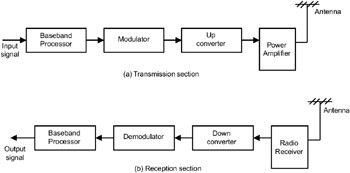12.2 RADIO COMMUNICATION SYSTEM
|
| < Day Day Up > |
|
12.2 RADIO COMMUNICATION SYSTEM
The block diagram of a radio communication system is shown in Figure 12.1. The transmission section consists of a baseband processor, which does the necessary filtering of the input signal by limiting the input signal bandwidth to the required value and digitizes the signal using analog-to-digital conversion. If the input signal is voice, the filter limits the bandwidth to 4kHz. If the input signal is video, the bandwidth will be limited to 5MHz. If the radio communication system is a digital system, necessary source coding is also done by the baseband processor. This signal is modulated using analog or digital modulation techniques.

Figure 12.1: Simplified block diagram of a radio communication system.
Suppose the radio communication system operates in the VHF band with a carrier frequency of 140MHz. The baseband signal is converted into the radio frequency in two stages. In the first stage, called the intermediate frequency (IF) stage, the signal is translated to an intermediate frequency. The most widely used standard IFs are 455kHz, 10.7MHz, and 70MHz. In the second stage, the signal is translated to the required radio frequency using an up-converter as shown in Figure 12.1(a). The up-converted signal is given to a power amplifier that pumps out the modulated radio waves with the desired power level through the antenna. The antenna can be an omnidirectional antenna, a sectoral antenna, or a directional antenna. An omnidirectional antenna radiates equally in all directions. A sectoral antenna radiates at a fixed area, such as a 60o arc, a 120o arc, and so on. A directional antenna transmits in a specific direction. Omnidirectional and sectoral antennas are used at base stations, and directional antennas are used at remote stations.
At the receiving end, the signal is received by the antenna, down-converted to the IF frequency, demodulated, and filtered, and the original signal is obtained. The baseband processor in the receiving section carries out the necessary decoding.
In a radio system, the baseband signal is first up-converted into an intermediate frequency (IF) and then to the desired radio frequency. Sometimes the up-conversion is done in two or more stages.
| Note | Some standard IF frequencies are: 455kHz, 10.7MHz, and 70MHz. HF and VHF systems generally use an IF of 455kHz. The antennas are broadly classified as directional antennas, sectoral antennas, and omnidirectional antennas. A directional antenna radiates in a specific direction. and an omnidirectional antenna radiates in all directions. Sectoral antennas radiate in a sector of 60/120°. |
|
| < Day Day Up > |
|
EAN: 2147483647
Pages: 313